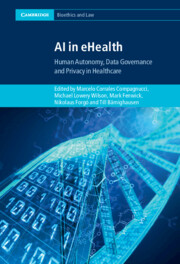Book contents
- AI in eHealth
- Cambridge Bioethics and Law
- AI in eHealth
- Copyright page
- Contents
- Contributors
- Preface
- Acronyms
- 1 Mapping the Digital Healthcare Revolution
- Part I Platforms, Apps and Digital Health
- Part II Trust and Design
- Part III Knowledge, Risk and Control
- Part IV Balancing Regulation, Innovation and Ethics
- 11 Doctors Without Borders? The Law Applicable to Cross-Border eHealth Services and AI-Based Medicine
- 12 Organisational Readiness for the Adoption of Artificial Intelligence in Hospitals
- 13 Regulating the ‘Benefits’ of eHealth
- 14 Data Protection Implications of Forensic Genealogy
- 15 Health Research, eHealth, and Learning Healthcare Systems
- Index
- Cambridge Bioethics and Law
- References
12 - Organisational Readiness for the Adoption of Artificial Intelligence in Hospitals
from Part IV - Balancing Regulation, Innovation and Ethics
Published online by Cambridge University Press: 08 September 2022
- AI in eHealth
- Cambridge Bioethics and Law
- AI in eHealth
- Copyright page
- Contents
- Contributors
- Preface
- Acronyms
- 1 Mapping the Digital Healthcare Revolution
- Part I Platforms, Apps and Digital Health
- Part II Trust and Design
- Part III Knowledge, Risk and Control
- Part IV Balancing Regulation, Innovation and Ethics
- 11 Doctors Without Borders? The Law Applicable to Cross-Border eHealth Services and AI-Based Medicine
- 12 Organisational Readiness for the Adoption of Artificial Intelligence in Hospitals
- 13 Regulating the ‘Benefits’ of eHealth
- 14 Data Protection Implications of Forensic Genealogy
- 15 Health Research, eHealth, and Learning Healthcare Systems
- Index
- Cambridge Bioethics and Law
- References
Summary
AI harbours considerable potential to improve diagnosis and therapy, enhance access to healthcare, and promote population health. AI-enabled healthcare is increasingly seen as part of the solution needed to address the growing gap between the supply and demand of hospital care. AI is well placed to help us tackle new challenges, though these novel applications are likely to render technology implementation even more complex. Yet, many hospitals within the EU are unprepared for this change. Historically, hospitals have faced multiple challenges when implementing new technologies. This chapter discusses the importance of AI readiness and highlights the benefits and limitations of a new policy tool: an AI Readiness Index for Hospitals (AI-RIH). We conceptualise AI readiness from an organisational perspective and discuss the dual functionality of the AI-RIH. For hospital managers, it could serve as a benchmarking tool. For policy-makers, it can help create targeted technology policies and measure their effectiveness. This chapter also discusses the conceptual challenges of indices and illustrates why a hospital index might provide more policy insights than an aggregated or national index. Finally, we explain how AI readiness can strengthen hospitals’ role as innovators and support the development and deployment of AI.
Keywords
- Type
- Chapter
- Information
- AI in eHealthHuman Autonomy, Data Governance and Privacy in Healthcare, pp. 334 - 377Publisher: Cambridge University PressPrint publication year: 2022
References
- 1
- Cited by



